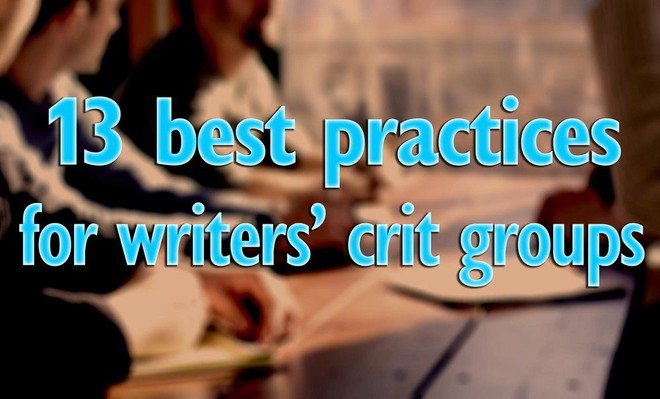13 best practices for creative writing critique groups
In this article:
The value of quality creative writing critique for authors should go without saying. When you write, you’re full of intention and ideas and inspiration. But readers don’t get that. Readers get only what’s on the page. Crit helps you get some distance from your writing so you can see more clearly what really is there in your text.
For an author, receiving crit can be hard—hopes and intentions getting cut down with just a few words. “You need to develop a thick skin,” they say. I say you mainly need to learn how to get some distance from the material.
Giving good and useful critique is also hard. It’s a learned skill. Everybody has an opinion, but not everyone knows how to give quality crit. What most find is that learning how to provide criticism an author can use makes them a better author.
This is why every author working on a project or projects can benefit from belonging to a crit group.
What makes a good crit group? #
After years of writing workshops in college and grad school, teaching a couple as an adjunct, and working in a handful of crit groups both good and not so much, I’ve seen a wide variety of styles and ground rules for author groups engaging in critique.
General approach #
Most crit groups fall into one of two basic categories.
- Reading aloud. People on a rotating or productivity basis bring pages in and read aloud (or better, someone else reads aloud and the writer must listen).
- Pre-submit and discuss. Everyone in the group distributes pages in advance of meeting, everyone reads everything, marking up the printouts (or digital files) with comments. Then, in the actual meeting you have timeboxed discussion on each takes place.
Reading out loud #
The first method was how some of my best writing workshops were run. There’s nothing like reading your text out loud to everyone. You hear your words with their ears. Awkward phrases, repetitions, overwriting, and errors leap up off the page. Your first time can be mortifying.
But it can be downright terrifying to hear someone else read your text aloud. Having to listen to your prose without any hint of performance to convey intention can reveal unintended line readings. You the author must sit there at the mercy of your own words there on the page.
The catch for this out loud approach is the time requirement. Reading out loud is slow. You can cover only so much material per hour—fine perhaps for a 3-hour workshop meeting 2–3 times a week, but maybe not so helpful for a crit group meeting two hours every two weeks.
Pre-submission (before crit group meeting) #
For a group of authors who are working on longer projects or a number of shorts, I think the second type of group can work best. Each person emails out their pages (up to a mutually agreed-upon word count) 4–7 days in advance of the gathering. Then your meeting time can focus completely on discussion of the work. This way, you can cover a lot more material.
Just remember that you’ll have to take time reading and critiquing everyone else’s pages, so the time commitment is more than just the actual meeting.
That covers the logistics. But what about the content of the crit itself. The first thing to remember is:
Critiquing is a learned skill #
“Everyone has a right to an opinion,” right? Sure. But crit requires more than having an opinion. It involves learning how to read someone else’s pages and provide helpful feedback that is informative, clear, and respects the author. Vague judgmental comments like “it sucks” are not helpful. Kid-gloves comments are not helpful either.

The goals of crit groups and workshops are:
- the writer gets quality feedback; and
- everyone learns to critique better.
Nobody is born being able to critique well. You have to learn from doing it. Guidelines can help.
8 Recommended Rules #
- Keep the group small. 4–6 people can work best, I feel. Large groups can be difficult to manage unless you’re meeting frequently, and that requires a larger time commitment, not only for the meetings but to read all those pages of submissions.
- As an author, don’t submit raw pages that you know have problems. Make it as good as you can first. That way feedback will hopefully reveal to you things you don’t know rather than just things you already know need to be fixed. It also means that your crit partners will (hopefully) enjoy reading your submissions more.
- Members who don’t participate are dead weight and should be asked to take a leave of absence and come back when they’re refreshed and ready to participate.
- Authors need to learn to separate themselves from their text. Everyone writes crap now and then. Don’t take crit as judgement of you as a writer. This is only about these particular pages.
- Matching genres can be very helpful. On the other hand, members coming from other diverse genres can be helpful too, as long as nobody is imposing their own genre tropes onto other genres.
- Virtual groups are possible, but work best with video (Skype, Hangouts, etc). Something about seeing each other helps. Audio-only sessions can feel less cohesive. In my experience it’s harder to sustain.
- Open online “crit sessions” can be the most difficult and least productive. Readers are reading once and are asked to give what amounts to snap responses. Experienced members (working authors and editors) tend to adapt to this environment better, but it’s still hard. For authors sharing, off-the-cuff feedback coming from random folks can be hard to process. Bad (as in least-helpful) crit is more likely when random folks can jump in. This is perhaps not for the newbie.
- Authors must be prepared to hear disappointing news. Feeling bummed is a natural response. Roll through it and when feeling clear, review your notes and decide what’s most helpful. Don’t get defensive. Hear the feedback with an open mind. You have final cut. You can reject any crit. This is your story.
5 Helpful Gudelines #
I won’t call these rules. Consider these my preferences.
- Critique the writing, not the author. This goes all the way to not saying, “You wrote…” Rather, stick to the text. “This paragraph…”
- Include comments about what’s working, what’s really great. Some groups even have a rule that you always open by saying something nice, but this isn’t about coddling author ego. It’s about helping an author who may have lost any sense of what’s working anymore. Comments about questions or anticipations you have on the first read can be very informative to the author.
- Don’t solve problems for the author. Having a group brainstorming “better” solutions can lead the author away from her own story. Sometimes it can be an absolutely demoralizing process, destroying the author’s faith in her own story instincts. Instead, use “bad examples” of solutions to help illustrate the problem and how the author might approach fixing it.
- Don’t ask the author to explain herself. This invites the unwelcome problem solving noted above. And it cultivates defensiveness on the author’s part. Crit is about the text. Those offering criticism aren’t there to judge. What matters in crit is what’s on the page.
- The author should remain silent until end of discussion. Then the author can ask follow-up questions. iAs an author, you should come to crit with some specific questions in mind. Ask those questions if nobody addressed them in their own feedback.
These are my druthers, drawn from experiences that reflect great privileges I was able to enjoy. My conclusions to date are nowhere near universal, but I hope some of these are helpful.
What are your thoughts?
